here I want to ask to you, what's the difference between running the gunicorn uvicorn with python, and default from tiangolo?
I have tried to stress testing these using JMeter with thread properties:

From these, I got the result::

From above I have tried:
- Dockerfile with tiangolo base
- Dockerfile with python:3.8-slim-buster and run it with gunicorn command
- Dockerfile with python:3.8-slim-buster and run it with python
This is my Dockerfile for case 1 (Tiangolo base):
FROM tiangolo/uvicorn-gunicorn-fastapi:python3.8-slim
RUN apt-get update && apt-get install wget gcc -y
RUN mkdir -p /app
WORKDIR /app
COPY ./requirements.txt /app/requirements.txt
RUN python -m pip install --upgrade pip
RUN pip install --no-cache-dir -r /app/requirements.txt
COPY . /app
This is my Dockerfile for case 2 (Python base with gunicorn command):
FROM python:3.8-slim-buster as builder
RUN apt-get update --fix-missing
RUN DEBIAN_FRONTEND=noninteractive apt-get install -y libgl1-mesa-dev python3-pip git
RUN mkdir /usr/src/app
WORKDIR /usr/src/app
COPY ./requirements.txt /usr/src/app/requirements.txt
RUN pip3 install -U setuptools
RUN pip3 install --upgrade pip
RUN pip3 install -r ./requirements.txt
COPY . /usr/src/app
ENTRYPOINT gunicorn --bind :8080 --workers 1 --threads 8 main:app --worker-class uvicorn.workers.UvicornH11Worker --preload --timeout 60 --worker-tmp-dir /dev/shm
This is my Dockerfile for case 3 (Python base with python command):
FROM python:3.8-slim-buster
RUN apt-get update --fix-missing
RUN DEBIAN_FRONTEND=noninteractive apt-get install -y libgl1-mesa-dev python3-pip git
RUN mkdir /usr/src/app
WORKDIR /usr/src/app
COPY ./requirements.txt /usr/src/app/requirements.txt
RUN pip3 install -U setuptools
RUN pip3 install --upgrade pip
RUN pip3 install -r ./requirements.txt --use-feature=2020-resolver
COPY . /usr/src/app
CMD ["python3", "/usr/src/app/main.py"]
Here I am confused, from the results above it looks like they have fairly the same results, what is the difference between the three methods above? which one is the best for production? I'm sorry, I'm new here in the production deployment API. I need some advice on this case. Thank you
This is my Cloud Run command
gcloud builds submit --tag gcr.io/gaguna3/priceengine
gcloud run deploy backend-pure-python \
--image="gcr.io/gaguna3/priceengine" \
--region asia-southeast2 \
--allow-unauthenticated \
--platform managed \
--memory 4Gi \
--cpu 2 \
--timeout 900 \
--project=gaguna3